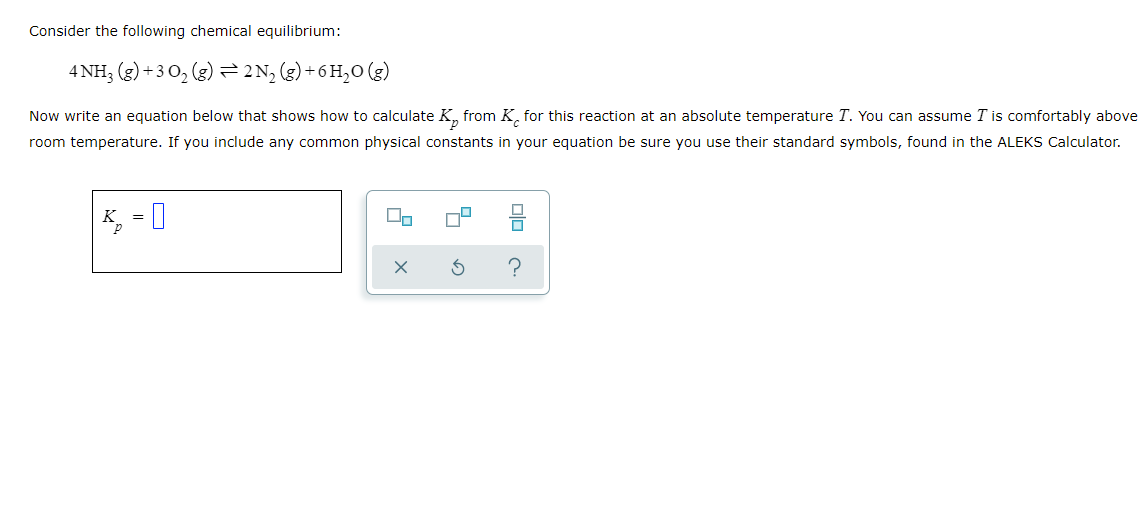Consider the following chemical equilibrium: 4 NH; (g) + 3 0, (g) =2N, (g)+6H,0 (g) Now write an equation below that shows how to calculate K, from K, for this reaction at an absolute temperature T. You can assume T is comfortably abov room temperature. If you include any common physical constants in your equation be sure you use their standard symbols, found in the ALEKS Calculator. K, = 0
Consider the following chemical equilibrium: 4 NH; (g) + 3 0, (g) =2N, (g)+6H,0 (g) Now write an equation below that shows how to calculate K, from K, for this reaction at an absolute temperature T. You can assume T is comfortably abov room temperature. If you include any common physical constants in your equation be sure you use their standard symbols, found in the ALEKS Calculator. K, = 0
Chemistry by OpenStax (2015-05-04)
1st Edition
ISBN:9781938168390
Author:Klaus Theopold, Richard H Langley, Paul Flowers, William R. Robinson, Mark Blaser
Publisher:Klaus Theopold, Richard H Langley, Paul Flowers, William R. Robinson, Mark Blaser
Chapter13: Fundamental Equilibrium Concepts
Section: Chapter Questions
Problem 12E: Show that the complete chemical equation, the total ionic equation, and the net ionic equation for...
Related questions
Question

Transcribed Image Text:Consider the following chemical equilibrium:
4 NH; (g) + 3 0, (g) =2N, (g)+6H,0 (g)
Now write an equation below that shows how to calculate K, from K, for this reaction at an absolute temperature T. You can assume T is comfortably above
room temperature. If you include any common physical constants in your equation be sure you use their standard symbols, found in the ALEKS Calculator.
Expert Solution
Step 1 : Explanation
The relationship between Kp and Kc is
=>,Kp = Kc (RT)Δn
where, Δn = ( moles of gaseous products - moles of gaseous reactants )
Trending now
This is a popular solution!
Step by step
Solved in 2 steps

Knowledge Booster
Learn more about
Need a deep-dive on the concept behind this application? Look no further. Learn more about this topic, chemistry and related others by exploring similar questions and additional content below.Recommended textbooks for you

Chemistry by OpenStax (2015-05-04)
Chemistry
ISBN:
9781938168390
Author:
Klaus Theopold, Richard H Langley, Paul Flowers, William R. Robinson, Mark Blaser
Publisher:
OpenStax

Chemistry: The Molecular Science
Chemistry
ISBN:
9781285199047
Author:
John W. Moore, Conrad L. Stanitski
Publisher:
Cengage Learning

Principles of Modern Chemistry
Chemistry
ISBN:
9781305079113
Author:
David W. Oxtoby, H. Pat Gillis, Laurie J. Butler
Publisher:
Cengage Learning

Chemistry by OpenStax (2015-05-04)
Chemistry
ISBN:
9781938168390
Author:
Klaus Theopold, Richard H Langley, Paul Flowers, William R. Robinson, Mark Blaser
Publisher:
OpenStax

Chemistry: The Molecular Science
Chemistry
ISBN:
9781285199047
Author:
John W. Moore, Conrad L. Stanitski
Publisher:
Cengage Learning

Principles of Modern Chemistry
Chemistry
ISBN:
9781305079113
Author:
David W. Oxtoby, H. Pat Gillis, Laurie J. Butler
Publisher:
Cengage Learning

Chemistry & Chemical Reactivity
Chemistry
ISBN:
9781337399074
Author:
John C. Kotz, Paul M. Treichel, John Townsend, David Treichel
Publisher:
Cengage Learning

Chemistry & Chemical Reactivity
Chemistry
ISBN:
9781133949640
Author:
John C. Kotz, Paul M. Treichel, John Townsend, David Treichel
Publisher:
Cengage Learning

Chemistry for Engineering Students
Chemistry
ISBN:
9781337398909
Author:
Lawrence S. Brown, Tom Holme
Publisher:
Cengage Learning